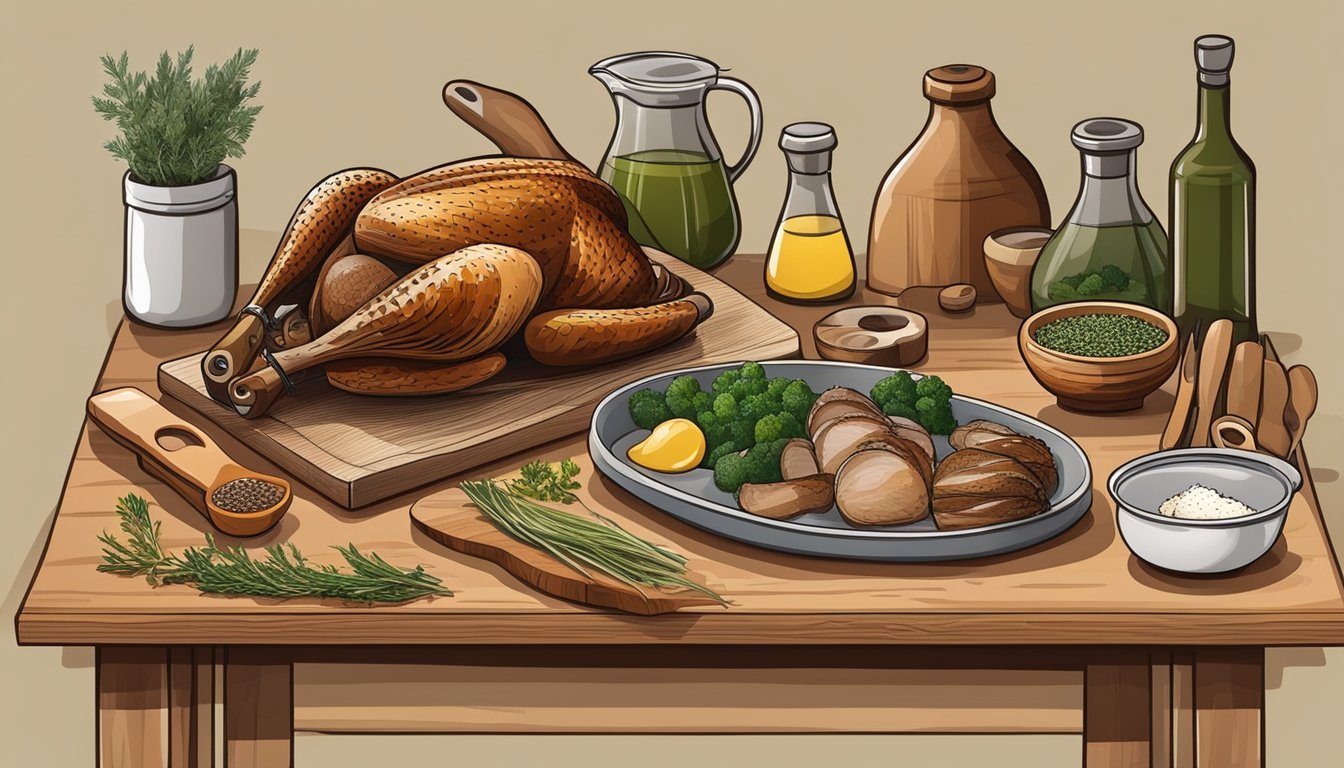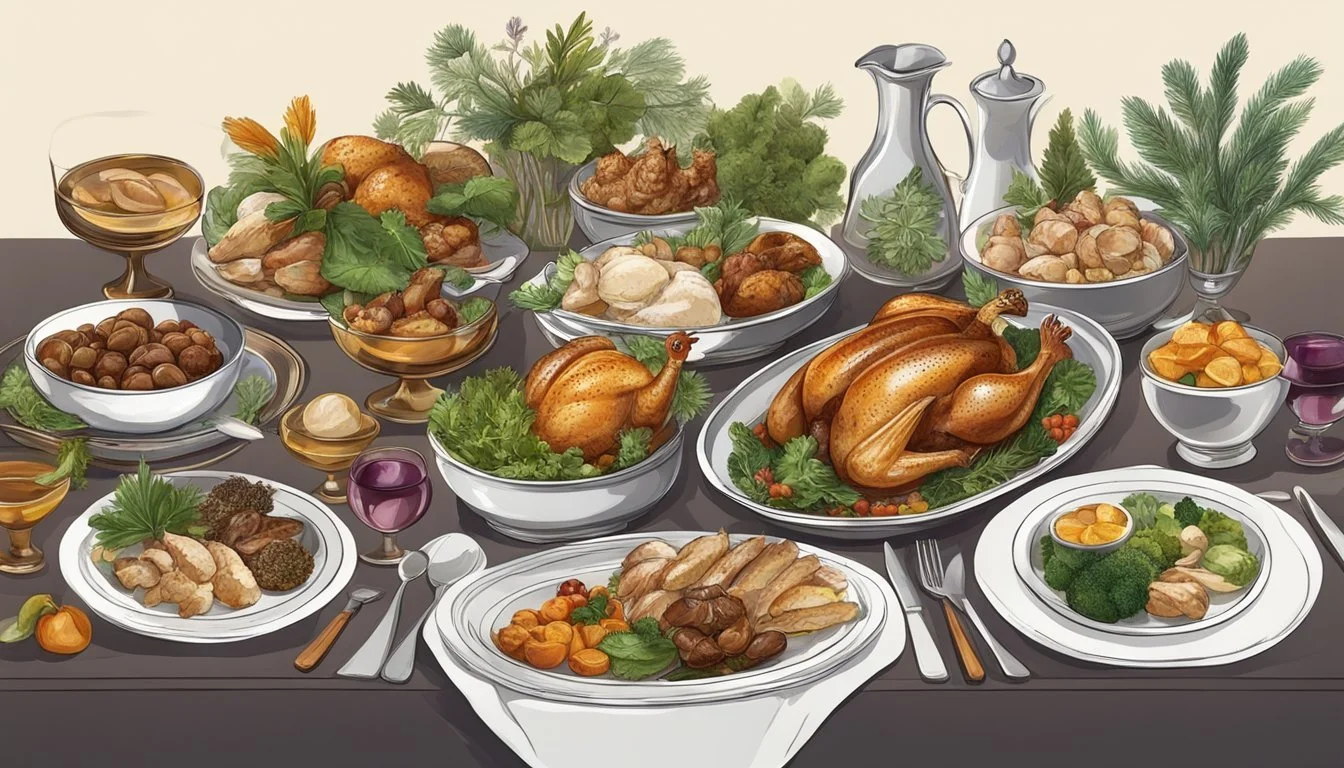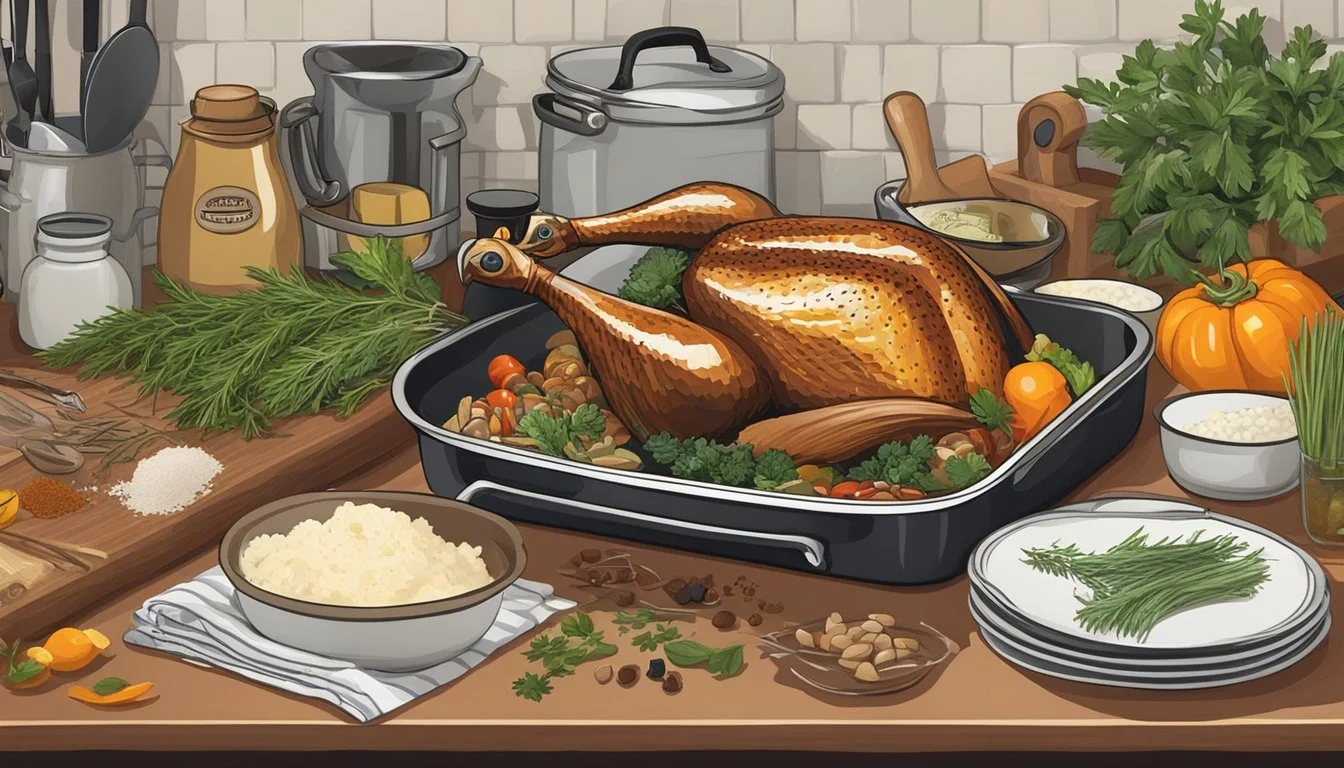Pheasant Substitutes
Best Alternatives for Your Recipes
For those seeking culinary alternatives to pheasant, there are numerous substitutes that can seamlessly replace this game bird in various recipes. Chicken is the most accessible and widely-used substitute for pheasant, offering a similar ability to absorb flavors when roasted. Additionally, its ubiquity in grocery stores makes it a convenient choice for cooks.
Quail, another excellent option, provides a taste profile close to that of pheasant, though it is smaller in size. Ground meats like turkey or venison sausage also work well in casseroles and pasta dishes, providing a hearty and seasoned flavor that complements many recipes.
For those following a plant-based diet, tofu delivers a versatile alternative with its ability to absorb marinades and spices, allowing it to mimic the texture and taste of pheasant in various cooking methods. Whether grilling, stir-frying, or roasting, these substitutes ensure that dishes remain flavorful and satisfying.
Understanding Pheasant Meat Characteristics
Pheasant meat is known for its distinctive flavor and texture, influenced by the bird's habitat and diet. The sections below provide details on these essential aspects.
Flavor and Texture Profile
Pheasant, a game bird, offers a unique flavor profile that sets it apart from more common poultry. Compared to chicken, pheasant meat is somewhat darker and denser. The meat has a mildly gamy flavor, especially in wild pheasants, which adds an earthy richness to dishes. Farm-raised pheasants tend to have a lighter, cleaner taste.
The texture of pheasant meat is lean and firm, which can make it less juicy but more robust in dishes. It's recommended to use moist cooking methods like braising or slow roasting to retain juiciness while preserving the meat's integrity.
Pheasant Habitat and Influence on Diet
Pheasants reside primarily in and around farmland, especially in the Upper Midwest region. Their natural habitat includes areas with ample cover and access to diverse food sources, such as seeds, grains, insects, and small vertebrates. This varied diet influences the meat's flavor, contributing to its distinctive gamy taste.
The habitat also affects the meat's texture. Wild pheasants, which lead more active lives than farm-raised birds, tend to have firmer, tougher meat. In contrast, farm-raised pheasants, with controlled diets and environments, produce meat that's tender and more consistent in quality.
Understanding these characteristics helps in selecting the best type of pheasant for various recipes, ensuring an optimal culinary experience.
Popular Pheasant Substitutes
Finding suitable substitutes for pheasant can be essential for achieving similar flavor profiles and textures in various dishes. Below are some popular alternatives, each tailored to culinary needs and preferences, from meat to plant-based options.
Chicken as a Substitute
Chicken is perhaps the most widely accessible pheasant substitute.
It roasts well, absorbs marinades effectively, and offers a familiar taste. Chicken breasts and thighs work best in recipes originally calling for pheasant due to their similar texture and cooking properties. Roasting a whole chicken can mimic the experience of having roast pheasant, especially when seasoned with herbs and spices like thyme and sage.
Cooking Tip: Use chicken thighs for a juicier texture.
Flavor Profile: Mild and versatile.
Best For: Roasts, stews, and casseroles.
Duck and Goose
Duck and goose provide a richer and slightly gamey flavor that closely resembles pheasant.
Duck breasts are particularly effective when pan-seared and served with fruit-based sauces, while goose can be roasted whole for festive occasions.
The duck fat enhances the flavor, making it a preferred choice for gourmet dishes. Both meats should be cooked to retain their moisture to avoid dryness.
Cooking Tip: Render the duck fat for added flavor.
Flavor Profile: Rich, gamey.
Best For: Roasts, gourmet dishes, and festive meals.
Other Game Bird Alternatives
Other game birds like quail, ruffed grouse, and partridge offer excellent substitutes for pheasant.
Quail is smaller but provides a similar taste profile. Ruffed grouse brings an authentic game bird flavor that is perfect for traditional hunters' recipes. These birds are best utilized in dishes that allow their unique flavors to shine, such as pan-roasted or stuffed preparations.
Cooking Tip: Season well and cook carefully to avoid overcooking.
Flavor Profile: Similar to pheasant, often milder.
Best For: Speciality dishes and traditional recipes.
Vegetarian Options
For those seeking a plant-based pheasant substitute, tofu and seitan offer versatile and flavorful alternatives.
Tofu, known for its ability to absorb marinades and spices, can mimic the texture of pheasant when grilled, stir-fried, or roasted. Seitan, made from wheat gluten, provides a chewy texture that works well in stews and casseroles.
Marinate these substitutes with bold flavors like soy sauce, garlic, and herbs to achieve a satisfying result.
Cooking Tip: Press tofu to remove excess water for better texture.
Flavor Profile: Mild, adaptable to various seasonings.
Best For: Stir-fries, stews, and casseroles.
Preparation Techniques for Pheasant and Its Substitutes
Proper preparation of pheasant ensures a flavorful and tender dish. Different cooking techniques like roasting, braising, searing, sautéing, and stewing bring out the best in both the game bird and its substitutes.
Roasting and Braising
Roasting pheasant involves high heat to create a crisp skin while keeping the meat juicy. Preheat the oven to 375°F (190°C). Season the pheasant with salt, pepper, and herbs like rosemary and thyme. Place in a roasting pan and cook for 1 to 1.5 hours, basting occasionally.
Braising is ideal to maintain moisture in lean substitutes like chicken and quail. Brown the meat on all sides in a heavy-bottomed pot. Add aromatic vegetables, herbs, and enough pheasant stock or broth to cover. Simmer on low heat for 1.5 to 2 hours until tender.
Searing and Sautéing
Searing locks in flavors by quickly cooking the outside of the pheasant or its substitutes. Heat oil in a skillet over medium-high heat. Cook the meat for 3-4 minutes per side until golden brown. This creates a flavorful crust while keeping the inside moist.
Sautéing is suitable for smaller cuts of meat like quail breasts. Use a hot pan and a small amount of oil or butter. Cook the meat quickly for 2-3 minutes per side, adding garlic or shallots for enhanced flavor. Serve with a reduction sauce made from the pan drippings.
Stewing Techniques
Stewing pheasant or its substitutes involves slow-cooking in liquid. Start by browning the meat in a pot. Add root vegetables, garlic, and herbs like bay leaves and thyme. Cover with pheasant stock or broth and cook on low heat for 2-3 hours.
This method is excellent for breaking down tougher cuts, resulting in a rich, hearty dish. The liquid becomes a thick, flavorful gravy, perfect over mashed potatoes or rice.
Selecting the Right Substitute for Your Recipe
Choosing the best substitute for pheasant in your recipe depends on the dish's flavor profile, cooking methods, and textural elements you wish to preserve. Each substitute has its own unique properties that can mimic pheasant effectively.
Factors to Consider
Flavor Profile: Pheasant has a mild, slightly gamey taste that can be replicated with chicken or quail. For a bolder flavor, venison sausage or turkey can be used, especially in hearty dishes.
Cooking Methods: Consider how the substitute will be cooked. For roasting, chicken or quail are ideal as they take on flavors well and maintain a tender texture. In stir-fries or grilled dishes, tofu can be a versatile meatless option.
Textural Contrast: Texture is crucial. Pheasant has a firm but tender bite. To replicate this, chicken and quail work well. Tofu, when pressed and marinated, can mimic this texture in vegetarian recipes. Ground meats like turkey or venison sausage are better suited for casseroles and pasta dishes.
Recipe-Specific Substitutions
Roast Pheasant: For a roast, chicken is the top choice due to its similar roasting properties. Quail can also be used for a closer flavor match but in smaller portions.
Pheasant Pot Pie: Substitutes like diced chicken or turkey work well. They absorb the flavors of the pot pie filling and provide a similar texture.
Pheasant Recipes: For diverse pheasant recipes, adapt the substitute to the cooking technique. Use tofu in stir-fries, ensuring it is well-marinated to emulate pheasant's flavor. Ground meats like turkey or venison sausage are excellent for dishes like casseroles and pasta, where they blend seamlessly with other ingredients.
Properly choosing substitutes ensures the success of your pheasant recipes while accommodating different tastes and preferences.
Specific Pheasant Dish Alternatives
When looking for alternatives to pheasant in specific dishes, it's essential to consider the texture, flavor, and cooking methods. The following options address these aspects effectively, providing suitable substitutions for game bird saddles, breasts, and wild game stews and pies.
Game Bird Saddles and Breasts
Quail: A smaller bird that offers a similar taste profile to pheasant. Quail saddles and breasts can be prepared in much the same way as pheasant, making them an excellent alternative. Quail roasts well and pairs beautifully with robust flavors and hearty sides.
Chicken: Widely available and versatile. Chicken breasts and thighs have a lighter taste but can be enhanced with marinades and spices. Its texture is similar when prepared properly, whether roasted, grilled, or pan-fried.
Duck: Offers a richer flavor than pheasant. Duck breasts provide a denser and more succulent option. They can be used in place of pheasant in most recipes, particularly where a deeper flavor is desired.
Wild Game Stews and Pies
Turkey: Ground turkey or turkey thighs work well in wild game stews and pot pies. They absorb flavors from hearty vegetables and spices, enhancing the overall taste. Turkey offers a similar consistency to pheasant in these dishes.
Venison: A rich, gamy alternative. Ground venison or venison stew meat can substitute for pheasant, providing a bold flavor that complements the wild game theme. When seasoned properly, it works particularly well in stews with a robust broth.
Wild Mushrooms: For a vegetarian option, wild mushrooms can mimic the earthy flavors found in wild game. Varieties like porcini or shiitake bring a similar depth and can be used in conjunction with root vegetables in stews and pies.
These alternatives ensure that your dishes maintain their intended flavor profiles, textures, and complexity, even when pheasant is not available.
Ancillary Aspects of Pheasant Cooking
Making full use of pheasant's unique attributes can enhance both flavor and presentation. Farm-to-table enthusiasts and culinary professionals alike find value in utilizing all parts of the bird.
Making Use of Pheasant Fat and Stock
Pheasant fat offers a flavor profile more refined than common poultry. It is ideal for roasting vegetables or making rich sauces. To render pheasant fat, start by trimming any excess fat from the bird and slowly heating it over low heat until it liquefies.
Pheasant stock, made from bones and leftover carcasses, provides a robust base for soups and stews. Simmer the carcass with aromatics like onions, carrots, and celery for several hours. Strain and store the stock in airtight containers for various recipes.
Utilizing Pheasant Feathers in Culinary Presentation
Pheasant feathers add a rustic aesthetic to culinary presentations. Clean and sanitize the feathers thoroughly before using them as garnish. They can be placed around serving dishes or incorporated into table settings for thematic decoration.
Feathers can also be crafted into napkin rings or used to embellish menus. They provide a natural touch that complements the earthy flavors of game bird dishes. Ethical sourcing and proper sanitation are crucial to ensure safe and visually appealing results.
By understanding these aspects, chefs and home cooks can elevate their pheasant dishes both in taste and presentation.
Culinary Considerations Beyond the Kitchen
Pheasant hunting contributes to sustainability through regulated practices, while culinary alternatives offer ethical choices for conscientious consumers.
Pheasant Hunting and Sustainability
Regulated pheasant hunting helps maintain population balance and supports conservation efforts. Hunters often follow strict guidelines to ensure sustainable practices, preventing overhunting. This regulation includes seasonal restrictions, bag limits, and licensing requirements.
Conservation programs funded by hunting licenses and fees aid habitat restoration. These initiatives benefit a variety of wildlife, not just pheasants. For those who enjoy the flavor of pheasant but seek more sustainable options, farm-raised pheasants provide a controlled alternative. This farming method reduces pressure on wild populations and ensures a steady supply for culinary use.
Ethical Considerations and Alternatives
For those concerned with animal welfare, ethical considerations play a crucial role. Subsisting on wild-caught pheasant raises questions about humane hunting methods and the impact on animal populations.
Alternatives like tofu and vegetable-based proteins offer cruelty-free choices. These substitutes can replicate the texture and flavor of pheasant with proper seasoning.
Moreover, choosing poultry such as chicken or quail supports ethical farming practices when sourced from humane, organic farms. These options not only align with ethical considerations but also offer similar culinary experiences. Awareness and informed choices in the kitchen contribute to a more ethical approach to cooking.









